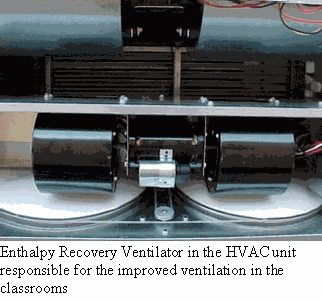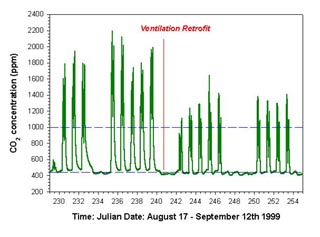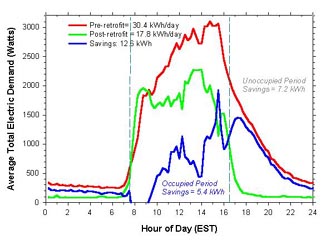
![]()
Retrofits: |
||
There are over 25,000 portable classrooms in Florida and each portable uses approximately 30 kWh/day. Since many schools have portables an energy solution may be generic; we anticipated that positive research results might have widespread application. Technologies tested in this project were an efficient lighting system, a reflective white metal roofing system, an efficient HVAC with an enthalpy recovery ventilator (ERV), and automated controls.
 Silver Sands Middle School in Volusia County was chosen as the study site.
Two portable classrooms identical in dimensions and configuration were used
for this side-by-side test of efficiency measures. The portables(096 and
035) were wood frame construction, 20' x 36', with the long axis facing east-west.
Silver Sands Middle School in Volusia County was chosen as the study site.
Two portable classrooms identical in dimensions and configuration were used
for this side-by-side test of efficiency measures. The portables(096 and
035) were wood frame construction, 20' x 36', with the long axis facing east-west.
The two classrooms were fully instrumented to measure roof surface, decking, attic, and interior temperatures as well as interior relative humidity. Carbon dioxide (CO2) was also measured as an indicator of indoor pollutant. CO2 levels above 1000 ppm were considered an indicator of poor indoor air quality. Total kWh, AC kWh, and lighting kWh were taken as well.
Baseline data was collected from September 1997 to May 1998 (a full school year). HVAC use and lighting use made up the vast majority of total energy use in both classrooms.
The retrofits were then sequenced into the buildings. The old T12 lamp-magnetic ballast lighting systems were replaced by a more efficient T8 lamp-electronic ballast lighting systems, the old 3 ton HVAC units were replaced with more efficient 2 ½ ton units with ERV, and the old gray asphalt shingle roofs were replaced with reflective white metal roofs.

Measured
interior carbon dioxide concentration in portable 096
before and after greater outdoor ventilation air was provided by ERV

Total
average daily demand in the year before (red) and
after (green) retrofit.Time of day energy savings are shown in blue
HVAC energy use on matched school days was reduced in portable 035 by 45%, with most of the savings coming during unoccupied times. This was due primarily to the occupancy control on the HVAC system.
The ventilation due to the ERV was vastly improved compared to the old system. The amount of ventilation air introduced into the classroom was increased by 500%! The cfm/student increased from 2.6 to 13.0 (ASHRAE standard 62-1989 is 15 cfm/student). In addition, the CO2 levels decreased by 43% while the relative humidity was still controlled to acceptable levels.
The reflective white metal roof reduced peak plenum temperatures by 25 oF. The effect of this on the sensible cooling load was significant.
HVAC savings were greatest in absolute terms in October (44% or 405kWh) while for lighting it was in February (63% or 659 kWh). Savings were lowest in for both HVAC (2% or 1 kWh) and lighting (55% or 138 kWh) was the month of December.
Total average daily energy savings were 12.6 kWh or 41%. Savings during occupied periods being 5.4 kWh while savings during the unoccupied periods were 7.2 kWh due to the retrofit measures. These retrofits were economical as well with a greater than 20% rate of return in investment for both retrofit of existing classrooms and for re-design of new facilities.
